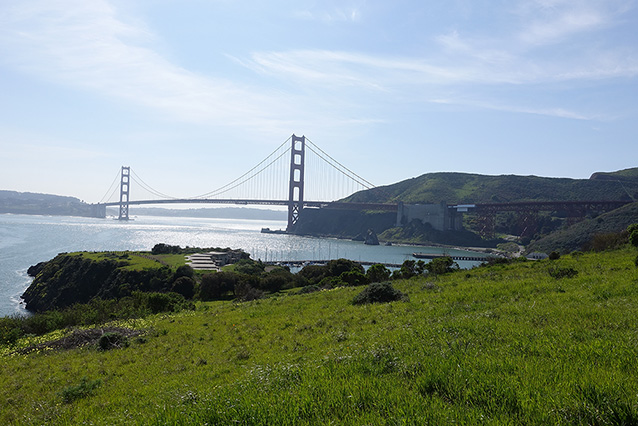Fort Baker, situated on the shore of the Marin Headlands in San Francisco Bay, is the site of one of the nation’s earliest coastal defense artillery batteries and is significant in the development of the coastal defense system. The period of significance is 1867 to 1946. Fort Baker, along with Forts Barry and Cronkhite, was included as a nationally-significant historic district in the National Register of Historic Places in 1973, due to the site’s significance in coastal defense system.
"… the [guns] themselves must be colored to harmonize with their surroundings in summer and winter; in a word, dispersion and concealment, as contrasted with concentration and armor, is the latest [word]…" "Course of Lectures upon the Defense of the Sea-Coast of the United States" by Henry L. Abbot, 1888

NPS

NPS
This site, strategically located in Marin County, commands views of the Bay entrance. In 1866, Forts Baker and Barry were acquired by purchase to be used for military defense. The fortifications which were proposed for construction on this land were intenced to augment those at the Presidio of San Francisco, in order to prevent successful passage of hostile ships through the Golden Gate into the San Francisco Bay.
Natural systems and features of the landscape had a strong influence on the design and development of Fort Baker. The natural topography, a relatively flat valley floor surrounded by steep hills, provided an exceptional vantage point into the San Francisco Bay and made Fort Baker an excellent strategic position. Further, the small harbor, Horseshoe Cove, was well suited to accommodate ships and played a vital role in the development of the post. The topographic manipulations affected the physical character of the landscape, including the five batteries, each one involved significant earthworks; the development of the parade ground and the waterfront, including considerable grading; and cuts and fills involved with road construction (and especially the Golden Gate Bridge).

NPS
Several circulation systems remain from the historic period, including the walkways and much of the road system. These connect the Batteries, the Parade Ground (and structures around Murray Circle), and the Quartermaster Warehouse. More than 100 historic structures are located at Fort Baker. As a group, the structures display architectural styles based on standardized plans developed by the Army and are good examples of military architecture widely used throughout the country in the early twentieth century.
Existing trees from the historic period can be found throughout the site. Among these are the even-aged stand of Monterey cypress trees, planted as a windbreak, and eucalyptus trees. Turfgrass is by far the most pervasive historic vegetative feature.
Fort Baker retains historical integrity as a military landscape. The site displays the seven aspects that determine integrity as defined by the National Register of Historic Places: location, design, setting, materials, workmanship, feeling, and association. The site retains the of the majority of the following landscape characteristics that contribute to its significance and integrity: natural systems and features, spatial organization, topography, circulation, cluster arrangement, vegetation, buildings and structures, views and vistas, and small scale features.
Quick Facts
- Cultural Landscape Type: Designed
- National Register Significance Level: National
- National Register Significance Criteria: A,C
- Period of Significance: 1867-1946
Landscape Links
- Cultural Landscapes Inventory park report
- Cultural Landscape Report for Forts Baker, Barry, and Cronkhite, Volume I: Site History
- Cultural Landscape Report for Forts Baker, Barry, and Cronkhite, Volume II: Existing Conditions through Treatment
- National Register of Historic Places: Forts Baker, Barry, and Cronkhite
- NPGallery Photos
- Landscape Flickr Album
- More about NPS Cultural Landscapes
Last updated: December 28, 2020
